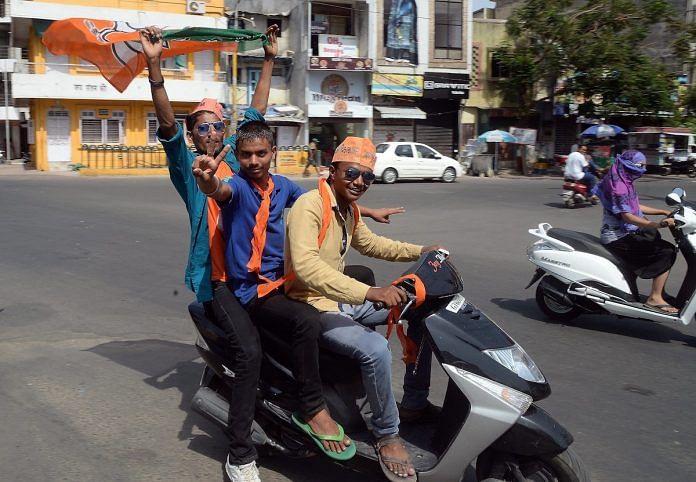The ‘vikas’ slogan that voters in Gujarat so proudly embraced just a few years ago has been turned upside down during this campaign.
The contemporary narrative of the Gujarat model of ‘vikas’ (development) has three components: catchy words and slogans, leader-centrism, and regional pride.
The ‘vikas’ slogan that Gujarati voters so proudly embraced just a few years ago has been turned upside down during this campaign. Understanding the power of these slogans of pride and vikas is key to this election.
When his tenure as chief minister began, Narendra Modi carved out an image of a ‘Hindu Hriday Samrat’ (the emperor of Hindu hearts), and gradually acquired the image of ‘Vikas Purush’ (man of development). In between, he also launched ‘Gujarat Gaurav Yatra’ for Gujarati pride, and ‘Aapanu Gujarat, Aagavu Gujarat’ (our Gujarat, distinct Gujarat).
For Modi, Hindutva and economic growth are not antithetical. But when the two come into contradiction, he tilts towards the former.
In 2003, he began organising the Gujarat global investor conference, and the slogan ‘Vibrant Gujarat’ took life.
Highlighting the buzzword ‘Gujarat Unlimited’, he announced that his government was “firmly committed to economic reforms”. NRI Gujaratis were urged to ‘revolutionise’ Gujarat with investments, and were offered transparency and fast-moving files in return, along with subsidies and tax holidays.
Economic growth did accelerate in Gujarat along with several other states between 2005 and 2010. On the eve of the 2007 assembly elections, Modi projected himself as the one who had achieved unprecedented growth, under whom the state was number one in India. His Powerpoint presentations, video-conferences, ‘e-governance’, ‘broadband telephony’ etc. mesmerised the media, multiplying his popularity.
He was projected as the ‘God with a beard’, a strong, courageous, ‘masculine’ leader. Stickers with Modi’s pictures and these slogans were widely distributed. Since 2004, school notebooks, mid-day meals, food packages to flood victims, and even letters from the RTO with driving licences have carried Modi’s picture.
An impression was manufactured that prior to his regime, Gujarat was backward.
In 2005, while facing a revolt within the party, he said: “What has not been done in the last forty-five years, we will do in the next forty-five months.”
Later, he said: “It is our misfortune that…after Gujarat came into existence in 1960, no one thought about the basic structure for development.”
However, Gujarat, since its inception, had followed what political economist Asheema Sinha calls “bureaucratic liberalism”, to attract investment during the mixed economy era. The state made striking progress in its industrial economy within a decade of its existence. Between 1974 and 1990, it attained the second highest position in receiving letters of intent. It attained third position in terms in net value-added production in 1984-85.
But by all accounts, Gujarat occupies middle or lower positions in human development indices.
Minimum wages in farm and non-farm sectors are lower than most of the states in India. The condition of primary and community health centres buildings and primary schools are better, but more than one-fifth of the positions of doctors and para-medical staff are vacant. There is a scarcity of medicine and functioning diagnostic instruments. Many schools do not have the required number of teachers.
But for an average middle class Gujarati, who has transformed in the last three decades from a cycle owner to a car owner, the state’s position on human development indices is unimportant. At best, they are figures to be used in seminar rooms.
However, these Gujaratis are affected by the rising cost of private health care and education. To appease them, Gujarat prepared a public health bill in 2009 with a view to monitoring private clinics, consultants, and hospitals. Under this, all health care centres had to display in Gujarati the list of services, consultation charges, and maintain records. The doctors’ lobby opposed the draft bill, and the government succumbed to them quickly. This has been forgotten.
Recently, middle-class parents made protested increasing fees of private schools. Under pressure, on the eve of the assembly elections, the government formed a committee to regulate the fees. Several school managements have gone to court and now, the government is helpless.
The ‘vikas’ narrative has been punctured with the nation’s as well as Gujarat’s downward trend in GDP, and rising unemployment. To pacify protesting jobless youth, the government has recently filled up a large number of government vacancies, and also regularised temporary, part-time, and contract-based ad hoc employees.
Demonetisation and GST, meanwhile, have hurt the trading community.
In this scenario, a narrative ridiculing BJP’s ‘vikas’ hype has been floated on social media, saying “vikas has gone crazy”. BJP’s counter slogan, “I am Vikas, I am Gujarat” has not caught on.
There is also a whisper campaign: stories about how a Muslim (Ahmed Patel) would be the CM if the Congress comes to power; fear of safety of Hindu girls; and stories of injustice to Sardar Vallabhbhai Patel and Morarji Desai by the Congress.
People are now told that Modi may not have controlled price and offered jobs, but one cannot doubt his commitment. They are asserting that that China has started fearing India, and the USA provided the red carpet to welcome our Prime Minister.
Fence-sitting voters are, once again, caught in a dilemma — between Gujarati pride and their experience of vikas.
Ghanshyam Shah is former national fellow, Indian Council of Social Science Research






